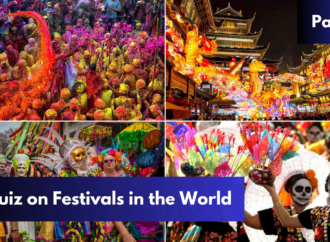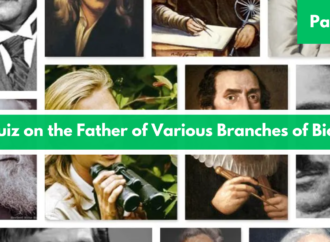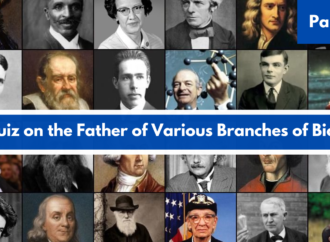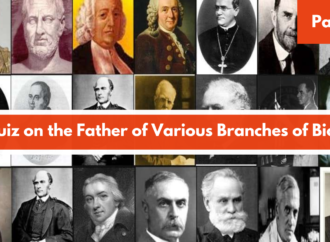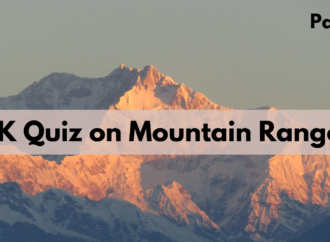GK Quiz on Punjab is one of the important topics in all state-level competitive exams under General Knowledge. Even Central Government Exams like UPSC, IBPS, SSC, Railways and Postal Exams focus more on the Individual States.
Attend our GK Quiz on Punjab and don’t forget to share your marks!!!
1. Punjab does not share it’s border with which of the following states?
a) Himachal Pradesh
b) Haryana
c) Rajasthan
d) Delhi
Click here to View Answer
Answer. D) Delhi. Larger Punjab region, the state is bordered by the Indian states of Jammu and Kashmir to the north, Himachal Pradesh to the east, Haryana to the south and southeast, Rajasthan to the southwest, and the Pakistani province of Punjab to the west.
2. Which of the following is an official language of Punjab?
a) Hindi
b) Punjabi
c) English
d) Sanskrit
Click here to View Answer
Answer. B) Punjabi. Punjabi is the most widely spoken and official language of the state.
3. What is the rank of Punjab by population, according to the census 2011?
a) 17th
b) 18th
c) 16th
d) 12th
Click here to View Answer
Answer c) 16th.The state covers an area of 50,362 square kilometres, 1.53% of India’s total geographical area. It is the 20th-largest Indian state by area. With 27,704,236 inhabitants at the 2011 census, Punjab is the 16th-largest state by population, comprising 22 districts.
4. Punjab means ‘state of five rivers’. Which one of the following river does not flow in Punjab?
a) Sutlej
b) Ravi
c) Beas
d) Ganga
Click here to View Answer
Answer. D) Ganga. The five rivers from which the region took its name were Sutlej, Ravi, Beas, Chenab and Jhelum; Sutlej, Ravi and Beas are part of the Indian Punjab.
5. Which of the following empire had Punjab as its home?
a) Gupta Empire
b) Alchon Huns
c) Harsha
d) All of the above
Click here to View Answer
Answer. D) all of the above. Punjab was home to the Gupta Empire, the empire of the Alcon Huns, the empire of Harsha, and the Mongol Empire. Circa 1000, Punjab was invaded by Muslims and was part of the Delhi Sultanate and Mughal Empire.
6. Which king united the Confederacy into the Sikh Empire?
a) Akbar
b) Ratan Singh
c) Ranjit Singh
d) None of the above
Click here to View Answer
Answer. C) Ranjit Singh. Sikhism originated in Punjab and resulted in the formation of the Sikh Confederacy after the fall of the Mughal Empire. The Confederacy was united into the Sikh Empire by Maharaja Ranjit Singh.
7. In 1947, the Punjab Province of British India was divided along religious lines into?
a) East Punjab
b) West Punjab
c) Both a and b
d) None of these
Click here to View Answer
Answer. C) both a and b. In 1947, the Punjab Province of British India was divided along religious lines into West Punjab and East Punjab. The western part was assimilated into the new country of Pakistan while the east stayed in India
8. In how many parts Punjab was divided in 1966?
a) 3
b) 2
c) 1
d) 4
Click here to View Answer
Answer. A) 3. The Indian Punjab, as well as PEPSU, was divided into three parts on the basis of language in 1966. Haryanvi-speaking areas (a dialect of Hindi) were carved out as Haryana, while the hilly regions and Pahari-speaking areas formed Himachal Pradesh, alongside the current state of Punjab.
9. Which city is known as “steel town” in Punjab?
a) Chandigarh
b) Amritsar
c) Gurugram
d) Mandi Gobindgarh
Click here to View Answer
Answer. D) Mandi Gobindgarh. Punjab has the largest number of steel rolling mill plants in India, which are in “Steel Town”—Mandi Gobindgarh in the Fatehgarh Sahib district.
10. Which is Punjab’s state animal?
a) Lion
b) Blackbuck
c) Tiger
d) Deer
Click here to View Answer
Answer. B) Blackbuck.
11. Which is Punjab’s state bird?
a) Vulture
b) Eagle
c) Crow
d) Sparrow
Click here to View Answer
Answer. B) Eagle. (Accipiter gentilis)
12. Which is Punjab’s state emblem?
a) Lion Capital of Ashoka
b) Ashoka piller
c) Indian flag
d) Ashok chakra
Click here to View Answer
Answer. A) Lion Capital of Ashoka.
13. During the period when the epic Mahabharata was written, Punjab was known as?
a) Ropar
b) Trigarta
c) Katoch
Click here to View Answer
Answer. B) Trigarta. During the period when the epic Mahabharata was written, around 800–400 BCE, Punjab was known as Trigarta and ruled by Katoch kings
14. The Vedic Civilization spread along the length of which river to cover most of northern India including Punjab?
a) Sindhu
b) Ganga
c) Brahmaputra
d) Sarasvati
Click here to View Answer
Answer. D) Sarasvati. The Vedic Civilization spread along the length of the Sarasvati River to cover most of northern India including Punjab. This civilisation shaped subsequent cultures in the Indian subcontinent. The Punjab region was ruled by many ancient empires including the Gandhara, Nandas, Mauryas, Shungas, Kushans, Guptas, Palas, Gurjara-Pratiharas and Hindu Shahis.
15. Which one of the following is world’s oldest university?
a) Nalanda
b) Takshashila
c) Oxford
d) None of these
Click here to View Answer
Answer. B) Takshashila. The world’s oldest university Takshashila flourished here, even before the Buddha’s birth. The Brahmins of this region are called ‘Saraswata’ after the legendary Saraswati river region, once known for the ashramas of the rishis. Hinduism has been prevalent in Punjab since historical times before the arrival of Islam and birth of Sikhism in Punjab. Some of the influential Sikh figures such as Guru Nanak, Guru Angad Dev, Guru Amar Das, Guru Ram Das, Banda Singh Bahadur, Bhai Mati Das, all originated from Hindu families of Punjab. Many of Punjab’s Hindus converted to Sikhism.
16. Which Sikh guru was killed by Aurangzeb?
a) Guru Har Gobind
b) Guru Amar Das
c) Guru Arjan dev
d) Guru Har Rai
Click here to View Answer
Answer. C) Guru Arjan dev. Jahangir, saw the Sikhs as a political threat. He arrested Guru Arjun Dev because of Sikh support for Khusrau Mirza and ordered him put to death by torture.
17. Which Sikh guru created Akal Takht?
a) Guru Har Gobind
b) Guru Amar Das
c) Guru Arjan dev
d) Guru Har Rai
Click here to View Answer
Answer. A) Guru Har Govind. Guru Arjan Dev’s martyrdom led to the sixth Guru, Guru Har Gobind, declaring Sikh sovereignty in the creation of the Akal Takht and the establishment of a fort to defend Amritsar.
18. Which Sikh guru established the Khalsa?
a) Guru Har Gobind
b) Guru Amar Das
c) Guru Arjan dev
d) Guru Gobind Singh
Click here to View Answer
Answer. D) Guru Gobind Singh. Guru Gobind Singh assumed the guruship in 1675 and to avoid battles with Sivalik Hill Rajas moved the guruship to Paunta. He built a large fort to protect the city and garrisoned an army to protect it. The Sikh community’s growing power alarmed Sivalik Hill Rajas, who attempted to attack the city, but the Guru’s forces routed them at the Battle of Bhangani. He moved on to Anandpur and established the Khalsa, a collective army of baptised Sikhs. The establishment of the Khalsa united the Sikh community against various Mughal-backed claimants to the guruship.
19. The Cis-Sutlej states were a group of states in modern Punjab and Haryana states lying between?
a) Sutlej River on the north
b) Himalayas on the east
c) Yamuna River and Delhi District on the south
d) Sirsa District on the west
e) All of these
Click here to View Answer
Answer. E) All of these. The Cis-Sutlej states were a group of states in modern Punjab and Haryana states lying between the Sutlej River on the north, the Himalayas on the east, the Yamuna River and Delhi District on the south, and Sirsa District on the west. These states were ruled by the Scindhia dynasty of the Maratha Empire.
20. In which year The Jallianwala Bagh Massacre occurred in Amritsar?
a) 1920
b) 1919
c) 1915
d) 1918
Click here to View Answer
Answer. B) 1919. The Jallianwala Bagh Massacre of 1919 occurred in Amritsar.
21. Lahore Resolution, demanding the creation of a separate state is passed by?
a) INC
b) Mahatma Gandhi
c) East India company
d) Muslim league
Click here to View Answer
Answer. D) Muslim league. the All-India Muslim League passed the Lahore Resolution, demanding the creation of a separate state from Muslim majority areas in India. This triggered bitter protests by the Sikhs in Punjab, who could not countenance living in a Muslim state.
22. In which type of plains Punjab lies?
a) Alluvial plains
b) Erosional plains
c) Structural plains
d) Glacial plains
Click here to View Answer
Answer. A) alluvial plains. Most of the Punjab lies in a fertile, alluvial plain with many rivers and an extensive irrigation canal system.
23. What is the climate of Assam?
a) Tropical
b) Sub-tropical
c) Tropical Monsoon Climate
d) Cold
Click here to View Answer
Answer. B) sub-tropical. The geography and subtropical latitudinal location of Punjab lead to large variations in temperature from month to month
24. In which city Famous Ram Bagh is situated?
a) Chandigarh
b) Amritsar
c) Gurugram
d) Mandi Gobindgarh
Click here to View Answer
Answer. B) Amritsar. Chhatbir Bansar Garden in Sangrur, Aam Khas Bagh in Sirhind, Amritsar’s famous Ram Bagh, Shalimar Garden in Kapurthala, and the famous Baradari Garden in the city of Patiala.
25. What number of districts are there in Punjab?
a) 26
b) 27
c) 22
d) 24
Click here to View Answer
Answer. C) 22. Punjab has 22 districts which are geographically classified into Majha, Malwa, Doaba and Poadh regions. They are officially divided among 5 divisions: Patiala, Rupnagar, Jalandhar, Faridkot and Firozepur.
26. What is the nick name of Punjab?
a) Granary of India
b) India’s bread-basket
c) Both a and b
d) None of the above
Click here to View Answer
Answer. C) both a and b. Punjab is one of the most fertile regions in India. The region is ideal for wheat-growing. Rice, sugar cane, fruits and vegetables are also grown. Indian Punjab is called the “Granary of India” or “India’s bread-basket”. produces 10.26% of India’s cotton, 19.5% of India’s wheat, and 11% of India’s rice.
27. Which is the largest cultivated crop in Punjab?
a) Cotton
b) Sugarcane
c) Rice
d) Wheat
Click here to View Answer
Answer. D) Wheat. The largest cultivated crop is wheat. Other important crops are rice, cotton, sugarcane, pearl millet, maize, barley and fruit. Rice and wheat are double cropped in Punjab with rice stalks being burned off over millions of acres prior to the planting of wheat. This widespread practice is polluting and wasteful.
28. Which is the folk dance of Punjab?
a) Bhangra
b) Dandia
c) Kucchipudi
d) Kathak
Click here to View Answer
Answer a) Bhangra. Bhangra dance began as a folk dance conducted by Punjabi farmers to celebrate the coming of the harvest season. The specific moves of Bhangra reflect the manner in which villagers farmed their land. This hybrid dance became Bhangra. The folk dance has been popularised in the western world by Punjabis in England, Canada and the USA where competitions are held.
29. Battle of Bhangani was fought between?
a) Muglas
b) Shivalik hills rajas
c) Britishers
d) None
Click here to View Answer
Answer. B) Shivalik hills rajas. Guru Gobind Singh assumed the guruship in 1675 and to avoid battles with Sivalik Hill Rajas moved the guruship to Paunta. He built a large fort to protect the city and garrisoned an army to protect it. The Sikh community’s growing power alarmed Sivalik Hill Rajas, who attempted to attack the city, but the Guru’s forces routed them at the Battle of Bhangani. He moved on to Anandpur and established the Khalsa, a collective army of baptised Sikhs, on 30 March 1699. The establishment of the Khalsa united the Sikh community against various Mughal-backed claimants to the guruship.











